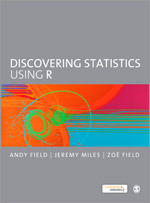Discovering Statistics Using R
- Andy Field - University of Sussex, UK
- Jeremy Miles - RAND Corporation, USA
- Zoë Field - University of Sussex, UK
Keeping the uniquely humorous and self-deprecating style that has made students across the world fall in love with Andy Field's books, Discovering Statistics Using R takes students on a journey of statistical discovery using R, a free, flexible and dynamically changing software tool for data analysis that is becoming increasingly popular across the social and behavioural sciences throughout the world.
The journey begins by explaining basic statistical and research concepts before a guided tour of the R software environment. Next you discover the importance of exploring and graphing data, before moving onto statistical tests that are the foundations of the rest of the book (for example correlation and regression). You will then stride confidently into intermediate level analyses such as ANOVA, before ending your journey with advanced techniques such as MANOVA and multilevel models. Although there is enough theory to help you gain the necessary conceptual understanding of what you're doing, the emphasis is on applying what you learn to playful and real-world examples that should make the experience more fun than you might expect.
Like its sister textbooks, Discovering Statistics Using R is written in an irreverent style and follows the same ground-breaking structure and pedagogical approach. The core material is augmented by a cast of characters to help the reader on their way, together with hundreds of examples, self-assessment tests to consolidate knowledge, and additional website material for those wanting to learn more.
Given this book's accessibility, fun spirit, and use of bizarre real-world research it should be essential for anyone wanting to learn about statistics using the freely-available R software.
Supplements
Here is the book that will make any student with even a passing interest in statistics ask themselves why bother about numbers and how to extract the best out of them. The authors rattle on excitedly for nearly 1000 pages about questions that deal not only with how to use R package, statistics and social science methods, they make the frequently dull reading on stats into a dedication to critical thinking. Highly commendable!
Andy Field's previous book "Discovering Statistics Using SPSS" has been consistently the most popular with our postgraduate health and social care students undertaking a research methods and statistics course.
As before, Andy Field's style is beyond irreverent ("If you are the sort of person who obsesses about p-values, then you can use the rcorr() function and p yourself with excitement at the outout it produces", pp 220-1). But then, one thing I have defineitely learnt from his SPSS book is that you cannot predict what writing style will work for a student and make the subject accessible and memorable. It may not be my choice of writing style for a textbook, but I will continue to recommend his books because they do the job.
However, if there is one major drawback to this book, it is the sheer bulk at 992 pages. It would be suitable for a statistics course lasting a whole semester or longer as it covers a huge range of topics. Despite the jokey style, it is no light introduction but rather a quite comprehensive journey through statistics and R. Indeed, Andy Field says in the introduction that his aim is to make this "the only statistics textbook anyone ever needs to buy"!
Readers will learn about statistics at the same time as using R for calculation and R as a programming language. I suspect this may require too much information to be stored and recalled at one time by the reader, but if one wanted to learn just statistics or just R, there would be more suitable focussed books.
The graphics chapter uses the advanced package ggplot2 from the very beginning, which I found surprising as some of the low-level functions are easier to get started on (there are fewer aspects to go wrong!). But this could motivate students by giving them high-quality graphics from the beginning.
Holding back discussion of categorical data until chapter 18 would be frustrating for most of my students, maybe not so in psychology (Field's field) where there are lots of scales as outcomes.
Some of the time the examples (of which there are many) use the R Commander graphical user interface, which could be one thing too many for readers to absorb.
A more interactive website with self-assessment content would be exciting! This could include R on the server so that pieces of code could be submitted by readers to get feedback on their understanding of the language. However, I realise that protecting this against malicious or just unfortunate code is quite a challenge.
I will definitely recommend this book to students interested in using R while they are learning stats, but with some caveats about its ease of use compared to a classic stats textbook and a simpler R introduction, of which there are several online.
Many good examples and student resources. Love the use of ggplot2 and Rcmdr - both great packages.
Too advanced for the undergraduate students.
Overall, I was positively impressed with this book. Andy Field has managed to transfer successfully his engaging (if somewhat discursive) style to the R environment. This can be very helpful for students who are unfamiliar with both statistics and R. I find his approach to R a bit heavier than absolutely necessary, making use of specialty libraries, complex commands, ggplot etc. It seems that the book is more like "how to use R to do what you did with other means" rather than immersing students to the R way of thinking about statistics and doing things. I would have stayed with a simpler approach, first making the most of the commonly available options and stressing the unity over structures and specifications. Field's approach might make the initial R experience a bit more frightening and discouraging, but admittedly it has at least two clear advantages: First, it lets him get through all of the material in "Discovering statistics..." in the same way as with SPSS, establishing common ground; and second, it gives a lot of information for future reference and more advanced analyses to students who are not too discouraged. Hopefully most students will be able to withstand the complexities of ggplot and appreciate the immense flexibility. Overall, this is a great book, obviously the result of a lot of work, and a solid resource for students to get a kick-start in both statistics and R.
I have already recommended the book to a class of graduate and doctoral students in which I lecture on R. I am also going to recommend it to my undergraduate class on introductory statistics. As there are no other books I know of that start at the beginning of both statistics and R, and because I have designed my introductory statistics course around R, I will consider and most likely recommend it for the next academic year as core textbook.
The book is somewhat less useful for those who choose not to base the course around R commander (the software wrapper used in the text). Nevertheless, it is quite good and directs the reader to the means to accomplish nearly anything they would normally run into.
I like this.
Comprehensive and juicy.
Good level for our students.
This is a very useful resource, very comprehensive, detailed, and illustrated with countless graphs, pictures and tables. Although the concept of the book is very broad (from introduction to statistics to the very details of "R") it is easy to read, and working with the book is fun (!).
The book is a very thorough and well written alternative to the SPSS version. However, it lacks the accessibility that makes the SPSS version stand out. My hope was that Andy Field would be the first to make R as accessible to students of statistics as SPSS. The book is the best effort I know off, but still falls short in comparison with the SPSS version. Hopefully, future versions will cause me to switch to R.
R can be rather cryptic. Andy Fields' book makes it possible to approach this software gradually from the scratch and in a not frightening way, repeating statistics at the same time. A very accessible book- I am going to use it for my course on introduction to data analysis.









